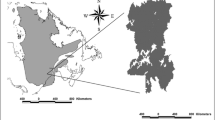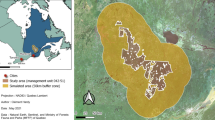Abstract
This study examines effects of different forest cutting patterns on habitat fragmentation in managed forest landscapes. We use computer simulation to conduct experiments in which we examine effects of different cutting patterns, cutting-unit size, and special constraints (e.g., a forest reserve, a stream system, or a road system) on landscape patterns. Fragmentation indices are used to quantify structural changes over the cutting cycle and among different treatments of the experiments. Degree of fragmentation varies greatly among the five cutting patterns used; aggregation of cutting units results in low degree and gradual change of fragmentation. Cutting patterns with larger cutting units and additional landscape constraints also lead to lower degree of fragmentation. Moreover, differences in fragmentation among the treatments are not observed until 30% or 50% of the landscape is cut.
Similar content being viewed by others
References
Baker, W.L. 1989. A review of models of landscape change. Landsc. Ecol. 2(2): 111–133.
Burgess, R.L. and Sharpe, D.M. (eds.). 1981. Forest Island Dynamics in Man-dominated Landscapes. Springer-Verlag, New York.
Fahrig, L. and Merriam, G. 1985. Habitat patch connectivity and population survival. Ecol. 66(6): 1762–68.
Forman, R.T.T. and Godron, M. 1986. Landscape Ecology. John Wiley & Sons, New York.
Franklin, J.F. 1989. Toward a new forestry. Amer. Forests 95(11/12): 37–44.
Franklin, J.F. and Forman, R.T.T. 1987. Creating landscape pattern by forest cutting: ecological consequences and principles. Landsc. Ecol. 1: 5–18.
Harris, L. 1984. The Fragmented Forest: Island Biogeography Theory and the Preservation of Biotic Diversity. University of Chicago Press, Chicago.
Li, H. 1989. Spatio-temporal pattern analysis of managed forest landscapes: a simulation approach. Dissertation, Oregon State University, Corvallis, Oregon.
Lovejoy, T.E., Bierregaard, R.O., Rylands, A.B., Malcolm, J.R., Quintela, C.E., Harper, L.H., Brown, K.S., Powell, A.H., Powell, G.V.N., Schubart, H.O.R., and Hays, M.B. 1986. Edge and other effects of isolation on Amazon forest fragments. In: Conservation Biology. pp. 257–285. Edited by M.E. Soule. Sinauer Associates, Sunderland, Massachusetts.
Ludwig, J.A. and Reynolds, J.F. 1988. Statistical Ecology. John Wiley & Sons, New York.
Maser, C., Tarrant, R.F., Trappe, J.M. and Franklin, J.F. (eds.). 1988. From the Forest to the Sea: A Story of Fallen Trees. USDA Forest Service General Technical Report PNW-GTR-229.
McLellan, C.H., Dobson, A.P., Wilcove, D.S. and Lynch, J.F. 1986. Effects of forest fragmentation on new- and old-world bird communities: empirical observations and theoretical implications. In: Wildlife 2000: Modeling Habitat Relationships of Terrestrial Vertebrates. pp. 305–313. Edited by J. Verner, M.L. Morrison, and C.J. Ralph. University of Wisconsin Press, Madison, Wisconsin.
Noss, R.F. 1987. Corridors in real landscapes: a reply to Simberloff and Cox. Conserv. Biol. 1(2): 159–164.
O'Neill, R.V., Krummel, J.R., Gardner, R.H., Sugihara, G., Jackson, B., DeAngelis, D.L., Milne, B.T., Turner, M.G., Zygmunt, B., Christensen, S.W., Dale, V.H., and Graham, R.L. 1988. Indices of landscape pattern. Landsc. Ecol. 1(3): 153–162.
Patton, D.R. 1975. A diversity index for quantifying habitat “edge”. Wildl. Soc. Bull. 3(4): 171–173.
Perry, D.A. 1988. Landscape pattern and forest pests. North-western Environ. J. 4: 213–228.
Ripple, W.J., Bradshaw, G.A. and Spies, T.A. 1991. Measuring forest landscape patterns in the Cascade Range of Oregon, USA. Conserv. Biol. 57: 73–88.
Romme, W.H. 1982. Fire and landscape diversity in subalpine forests of Yellowstone National Park. Ecol. Monogr. 52: 199–221.
Rosenberg, K.V. and Raphael, M.G. 1986. Effects of forest fragmentation on vertebrates in Douglas-fir forests. In: Wildlife 2000: Modeling Habitat Relationships of Terrestrial Vertebrates. pp. 263–272. Edited by J. Verner, M.L. Morrison, and C.J. Ralph. University of Wisconsin Press, Madison, Wisconsin.
Simberloff, D. 1988. The contribution of population and community biology to conservation science. Ann. Rev. Ecol. Syst. 19: 473–511.
Temple, S.A. 1986. Predicting impacts of habitat fragmentation on forest birds: a comparison of two models. In: Wildlife 2000: Modeling Habitat Relationships of Terrestrial Vertebrates. pp. 301–304. Edited by J. Verner, M.L. Morrison, and C.J. Ralph. University of Wisconsin Press, Madison, Wisconsin.
Temple, S.A. and Wilcox, B.A. 1986. Predicting effects of habitat patchiness and fragmentation. In: Wildlife 2000: Modeling Habitat Relationships of Terrestrial Vertebrates. pp. 261–262. Edited by J. Verner, M.L. Morrison, and C.J. Ralph. University of Wisconsin Press, Madison, Wisconsin.
Verner, J., Morrison, M.L., and Ralph, C.J. (eds.) 1986. Wildlife 2000: Modeling Habitat Relationships of Terrestrial Vertebrates. University of Wisconsin Press, Madison, Wisconsin.
Whitcomb, R.F., Robbins, C.S., Lynch, J.F., Whitcomb, B.L., Klimkiewicz, M.K. and Bystrak, D. 1981. Effects of forest fragmentation on avifauna of the Eastern deciduous forests. In: Forest Island Dynamics in Man-dominated Landscapes. pp. 125–206. Edited by R.L. Burgess and D.M. Sharpe. Springer-Verlag, New York.
Wilcove, D.S., McLellan, C.H., and Dobson, A.P. 1986. Habitat fragmentation in the temperate zone. In: Conservation Biology. pp. 237–256. Edited by M.E. Soule. Sinauer Associates, Sunderland, Massachusetts.
Wilcox, B.A. and Murphy, D.D. 1985. Conservation strategy: the effects of fragmentation on extinction. Amer. Natur. 125: 879–887.
Author information
Authors and Affiliations
Rights and permissions
About this article
Cite this article
Li, H., Franklin, J.F., Swanson, F.J. et al. Developing alternative forest cutting patterns: A simulation approach. Landscape Ecol 8, 63–75 (1993). https://doi.org/10.1007/BF00129867
Issue Date:
DOI: https://doi.org/10.1007/BF00129867




